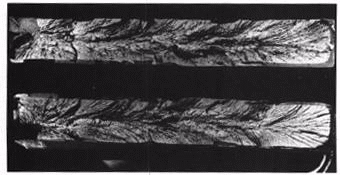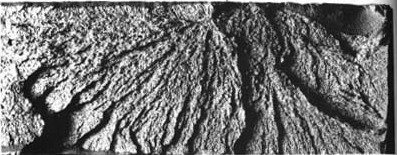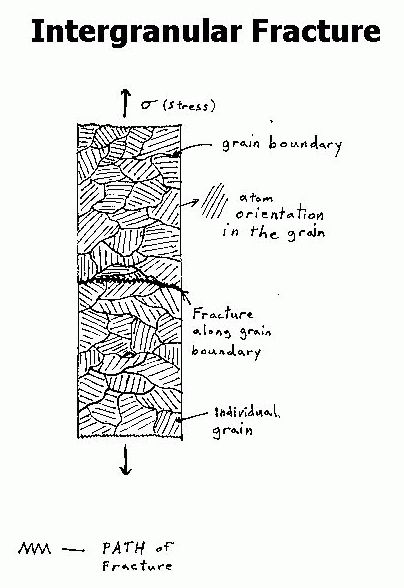
Chevron Fracture Surface (Callister p. 185)
Welcome fellow engineering students to the brittle fracture section of the fracture homepage. In this section of the homepage brittle fracture will be explained in simple and easy to understand terms. To start the topic off, what is brittle fracture? Basically, brittle fracture is a rapid run of cracks through a stressed material. The cracks usually travel so fast that you can't tell when the material is about to break. In other words, there is very little plastic deformation before failure occurs. In most cases, this is the worst type of fracture because you can't repair visible damage in a part or structure before it breaks.
In brittle fracture, the cracks run close to perpendicular to the applied stress. This perpendicular fracture leaves a relatively flat surface at the break. Besides having a nearly flat fracture surface, brittle materials usually contain a pattern on their fracture surfaces. Some brittle materials have lines and ridges beginning at the origin of the crack and spreading out across the crack surface.
Other materials, like some steels have back to back V-shaped markings pointing to the
origin of the crack. These V-shaped markings are called chevrons. Very
hard or fine grained materials have no special pattern on their fracture surface,
and amorphous materials like ceramic glass have shiny smooth fracture surfaces.

Chevron Fracture Surface (Callister p. 185)

Radiating Ridge Fracture Surface (Callister pg. 186, copyright by John Wiley & Sons, inc.)

The second type of fracture is intergranular fracture.
Intergranular fracture is the crack traveling along the grain boundaries, and not through
the actual grains. Intergranular fracture usually occurs when the phase
in the grain boundary is weak and brittle ( i.e. Cementite in Iron's grain boundaries). Think
of a metal as one big 3-D puzzle. Transgranular fracture cuts through the puzzle pieces,
and intergranular fracture travels along the puzzle pieces pre-cut edges.

In fracture, there are many shades of gray. Brittle fracture and ductile fracture are fairly general terms describing the two opposite extremes of the fracture spectrum. I will explain the factors that make a material lean toward one type of fracture as opposed to the other type of fracture.
When temperature decreases however, the exact opposite is true. Atom vibration decreases, and the atoms do not want to slip to new locations in the material. So when the stress on the material becomes high enough, the atoms just break their bonds and do not form new ones. This decrease in slippage causes little plastic deformation before fracture. Thus, we have a brittle type fracture.
At moderate temperatures (with respect to the material) the material exhibits characteristics of both types of fracture. In conclusion, temperature determines the amount of brittle or ductile fracture that can occur in a material.
Another factor that determines the amount of brittle or ductile fracture that occurs in a material is dislocation density. The higher the dislocation density, the more brittle the fracture will be in the material. The idea behind this theory is that plastic deformation comes from the movement of dislocations. As dislocations increase in a material due to stresses above the materials yield point, it becomes increasingly difficult for the dislocations to move because they pile into each other. So a material that already has a high dislocation density can only deform but so much before it fractures in a brittle manner. The last factor is grain size. As grains get smaller in a material, the fracture becomes more brittle. This phenomena is do to the fact that in smaller grains, dislocations have less space to move before they hit a grain boundary. When dislocations can not move very far before fracture, then plastic deformation decreases. Thus, the material's fracture is more brittle.
In ending, I would like to say that these are just the basics of brittle fracture. There are whole books written on just brittle fracture. So, if this section interested you at all, go look the books up at your local university library.
Good Luck with your studies MSE 2034/44 students.
Submitted by Jerry Ballard
Virginia Tech Materials Science and Engineering
http://www.eng.vt.edu/eng/materials/classes/MSE2094_NoteBook/97ClassProj/exper/ballard/www/ballard.html
Last updated: 4/25/97